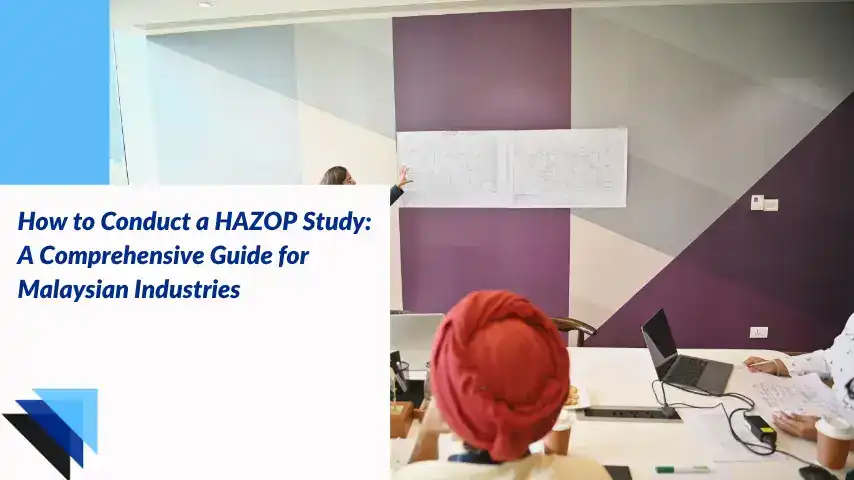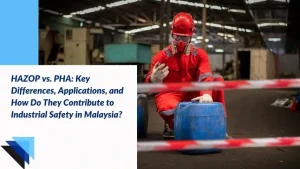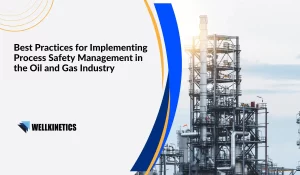The proper implementation of a HAZOP (Hazard and Operability) study is crucial for ensuring operational safety in Malaysian industries. A well-executed HAZOP study can identify potential hazards and operational issues before they become critical problems.
Want to master the art of conducting effective HAZOP studies? You’re in the right place.
This comprehensive guide breaks down the HAZOP study process into manageable steps, specifically tailored for Malaysian industrial settings. From assembling the right team to documenting findings, we’ll cover everything you need to know to:
- Build a qualified multidisciplinary team
- Prepare essential documentation
- Execute systematic node analysis
- Implement proper safeguards
- Manage action items effectively
Whether you’re a safety professional, process engineer, or operations manager, this step-by-step guide will help you conduct thorough HAZOP studies that enhance your facility’s safety and operational efficiency.
Need Expert Help to Facilitate Your HAZOP Study?
Make sure your HAZOP process is thorough and meets Malaysian safety standards with our experienced facilitators guiding your team.
- What Is the Importance of Building an Effective HAZOP Team?
- What Are the Key Preparation Phase Requirements for a HAZOP Study?
- How Is a HAZOP Study Conducted to Identify Hazards and Operability Issues?
- What Are the Key Hazard Identification Techniques Used in an Effective HAZOP Study?
- What Is the Role of Risk Assessment and Control Measures in a HAZOP Study?
- How Wellkinetics Can Help
What Is the Importance of Building an Effective HAZOP Team?
A well-structured HAZOP team forms the foundation of a successful hazard and operability study. The team’s collective expertise and diverse perspectives ensure comprehensive risk identification and assessment.
What Are the Essential Roles and Responsibilities in a HAZOP Team?
The HAZOP team must be carefully assembled with the right mix of expertise and experience. A typical multidisciplinary HAZOP team consists of 6-15 members, each bringing unique insights to the analysis.
The team leader serves as the facilitator, guiding discussions and ensuring the study stays focused. They must possess strong leadership skills and deep understanding of HAZOP methodology.
Key team member roles include:
- HAZOP Facilitator: Guides the HAZOP study, ensures systematic analysis, and keeps the team focused and objective
- Process Engineer: Provides detailed technical knowledge
- Operations Representative: Offers practical operational insights
- Safety Specialist: Ensures compliance with safety standards
- Maintenance Expert: Addresses equipment reliability concerns
- Scribe: Documents findings and recommendations accurately
Each team member contributes their specialized knowledge while collaborating effectively with others. The diverse composition helps identify potential hazards that might be overlooked by a single discipline.
For optimal results, the team should:
- Meet regularly throughout the study
- Maintain open communication channels
- Challenge assumptions constructively
- Document all findings systematically
- Follow up on action items promptly
The success of a HAZOP study largely depends on how well the multidisciplinary HAZOP team works together under the guidance of an experienced team leader.
What Qualifications Should a HAZOP Team Leader Possess in Malaysia?
A HAZOP team leader should have at least 5 years of experience in process safety, formal HAZOP leadership training, and strong facilitation skills. They should be familiar with Malaysian safety regulations, possess technical knowledge of the process, and have experience in systematic assessment tools and risk management techniques.
Want to Train Your Team for Independent HAZOP Success?
Equip your staff with practical skills and knowledge to confidently conduct future HAZOP studies in your facility.
What Are the Key Preparation Phase Requirements for a HAZOP Study?
The preparation phase focuses on gathering accurate and up-to-date documentation to support a structured and effective HAZOP study. It ensures that all required resources are in place, enabling the team to conduct a thorough and well-informed hazard analysis from the outset.
What Documentation and Resources Are Essential for the HAZOP Preparation Phase?
The preparation phase of a HAZOP study demands a systematic approach to ensure all necessary documentation and resources are readily available. This critical stage sets the foundation for a successful analysis and requires meticulous attention to detail.
Before initiating the HAZOP study, gather and organize all relevant process documentation. This includes up-to-date Process Flow Diagrams (PFDs), Piping and Instrumentation Diagrams (P&IDs), operating procedures, and equipment specifications. These documents form the backbone of the structured approach to hazard identification.
The HAZOP documentation must be current and accurately reflect the existing system configuration. Process engineers should verify that all diagrams are properly marked with revision numbers and dates. Any recent modifications or changes to the system should be clearly documented to prevent confusion during the analysis.
Essential resources to compile include:
- Process safety information
- Operating manuals and procedures
- Equipment maintenance records
- Previous incident reports
- Emergency response procedures
- Design basis documentation
- Material safety data sheets
Establish a centralized repository for all HAZOP documentation to ensure easy access for team members. This organized approach helps maintain consistency throughout the study and provides a clear audit trail for future reference.
Consider implementing a document control system to track changes and maintain version control. This structured approach to documentation management helps prevent confusion and ensures all team members work with the most current information.
How Frequently Should Malaysian Industries Conduct HAZOP Studies?
Malaysian industries should conduct HAZOP studies every 3-5 years for existing facilities, or whenever significant modifications are made to the process. For new installations, a HAZOP study should be performed during the design phase and reviewed before commissioning. Regular reviews ensure continued safety and operational efficiency.
How Is a HAZOP Study Conducted to Identify Hazards and Operability Issues?
Conducting the Hazard and Operability study involves a detailed and methodical examination of each part of the process to identify potential hazards and operability concerns. By analyzing defined nodes and applying guidewords to key parameters, the team systematically uncovers deviations that could impact safety or performance.
What Is Node Analysis and How Is It Used in a HAZOP Study?
In a HAZOP study, node analysis forms the foundation of systematic hazard identification. The process begins by breaking down the system or process into manageable sections called nodes. Each node represents a specific point or section where process parameters can deviate from normal operating conditions.
During the HAZOP process, the team methodically examines each node using guidewords to identify potential deviations. This structured approach ensures no critical aspects are overlooked, contributing to a successful HAZOP study. The analysis typically starts from the input of the process and moves systematically through to the output.
What Are the Key Parameters Examined in a HAZOP Study and How Are They Analyzed?
Parameters are specific physical or chemical properties that are crucial to the safe operation of the process. Common parameters examined in a HAZOP study include:
- Flow
- Temperature
- Pressure
- Level
- Composition
- Phase
- Time
For each parameter, the team applies guidewords such as “More,” “Less,” “No,” or “Reverse” to identify potential deviations. This systematic evaluation helps uncover possible hazards and operability issues that might not be immediately apparent.
The HAZOP process requires careful documentation of each parameter’s normal operating range and the potential consequences of deviations. The team must consider both the immediate effects and possible downstream impacts of parameter variations.
When analyzing parameters, it’s essential to:
- Document the design intent for each parameter
- Consider all possible deviations
- Evaluate existing safeguards
- Assess the adequacy of control measures
- Recommend additional safety measures where needed
What Is the Average Duration of a Typical HAZOP Study in Malaysian Industries?
A typical HAZOP study in Malaysian industries can take anywhere from 2-5 days for simple processes to several weeks for complex operations. The duration depends on factors like process complexity, system size, and team availability. For large chemical plants, it’s recommended to break the study into manageable sessions.
What Are the Key Hazard Identification Techniques Used in an Effective HAZOP Study?
Hazard identification forms the cornerstone of any effective HAZOP study. It involves systematically examining each process node to uncover potential risks that could impact safety, operations, or the environment. This structured approach ensures no critical hazards are overlooked during the assessment.
How Can Guide Words Be Used Effectively During a HAZOP Study to Identify Workplace Hazards?
Guide words serve as powerful tools in identifying workplace hazards during a HAZOP study. These standardized terms help teams explore various scenarios and potential deviations from normal operating conditions. When examining processes involving hazardous chemicals, guide words like “More,” “Less,” “No,” or “Reverse” are applied to process parameters.
For instance, when analyzing flow in a chemical reactor, the team might consider:
- More Flow: Could lead to overflow or increased reaction rates
- Less Flow: Might cause insufficient cooling or reaction issues
- No Flow: Potential for system shutdown or safety valve activation
- Reverse Flow: Risk of contamination or equipment damage
The systematic application of guide words ensures thorough hazard identification across all process aspects. Teams should document each potential hazard discovered, along with existing safeguards and recommended actions for risk mitigation.
To maximize the effectiveness of guide words:
- Apply them consistently across all process parameters
- Consider both immediate and long-term consequences
- Document all findings systematically
- Focus on credible scenarios
- Validate identified hazards with team expertise
When dealing with hazardous chemical processes, special attention must be given to:
- Chemical compatibility issues
- Storage and handling procedures
- Emergency response scenarios
- Personal protective equipment requirements
- Ventilation and containment systems
RELATED: Understanding Process Hazards and How to Effectively Address Them
What Is the Role of Risk Assessment and Control Measures in a HAZOP Study?
A comprehensive risk assessment forms the foundation of an effective HAZOP study, enabling teams to identify and evaluate potential hazards systematically. This process involves analyzing each deviation’s likelihood and severity to determine the level of risk it poses to personnel, equipment, and the environment.
When conducting risk assessments, teams must consider both immediate and long-term consequences. This includes evaluating the potential impact on operational efficiency, worker safety, and environmental compliance. The assessment should account for existing safeguards and their effectiveness in mitigating identified risks.
How Are Safety Controls Implemented and Maintained After Hazard Identification in a HAZOP Study?
After identifying potential risks, implementing robust control measures becomes crucial. These measures typically follow the hierarchy of controls, starting with elimination or substitution where possible, followed by engineering controls, administrative controls, and personal protective equipment as a last resort.
Engineering controls might include installing automated shutdown systems, pressure relief valves, or containment systems. Administrative controls often involve developing standard operating procedures, conducting regular training sessions, and implementing maintenance schedules.
The effectiveness of control measures should be regularly monitored and reviewed to ensure they continue to provide adequate risk reduction. This involves:
- Conducting periodic audits of safety systems
- Reviewing incident reports and near-miss data
- Updating control measures based on new technology or industry best practices
- Ensuring proper documentation of all safety controls and their maintenance
It’s essential to maintain clear communication channels between all stakeholders involved in implementing and maintaining these safety controls. Regular feedback from operators and maintenance personnel can help identify potential improvements in the control measures.
Looking to Prioritize and Manage Risk Controls Effectively?
Get actionable recommendations to reduce hazards and boost your facility’s operational safety.
How Does HAZOP Integrate with Other Safety Management Systems in Malaysian Facilities?
HAZOP studies complement other safety systems by providing input for emergency response plans, maintenance schedules, and operating procedures. The findings are incorporated into the facility’s overall risk assessment framework and help identify areas requiring better control measures and safety professional intervention.
How Wellkinetics Can Help
At Wellkinetics, we know that conducting a successful HAZOP study can be complex and time-consuming. That’s why we offer expert support tailored to Malaysian industries to help you navigate every step with confidence and accuracy.
Our experienced team works closely with your organization to ensure your HAZOP study is thorough, effective, and aligned with local regulations. We provide:
- Expert Facilitation: We lead your multidisciplinary team through a structured HAZOP process, making sure every potential hazard is identified and addressed.
- Practical Training: We equip your staff with the knowledge and skills to carry out future HAZOP studies independently, strengthening your internal safety capabilities.
- Actionable Recommendations: We assist in prioritizing and managing risk control measures so you can reduce hazards efficiently and improve operational safety.
Partner with Wellkinetics to streamline your HAZOP study process, minimize risks, and protect your workforce and assets. Contact us today to learn how we can help you build a safer, more reliable operation.
Learn more about our process safety management consultancy services.




